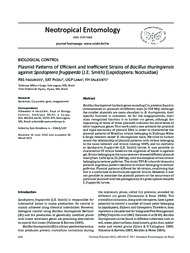Plasmid patterns of efficient and inefficient strains of Bacillus thuringiensis against Spodoptera frugiperda (J.E. Smith) (Lepidoptera: Noctuidae).
Plasmid patterns of efficient and inefficient strains of Bacillus thuringiensis against Spodoptera frugiperda (J.E. Smith) (Lepidoptera: Noctuidae).
Author(s): FAGUNDES, R. B. S.; PICOLI, E. A. T.; LANA, U. G. P.; VALICENTE, F. H.
Summary: Bacillus thuringiensis harbors genes encoding Cry proteins found in chromosomes or plasmids of different sizes (4-150 Mb). Although the smaller plasmids are more abundant in B. thuringiensis, their specific function is unknown. As for the megaplasmids, their main recognized function is to harbor cry genes, although the sequencing of some of these plasmids indicates the occurrence of other important genes. This work used a new protocol for practical and rapid extraction of plasmid DNA in order to characterize the plasmid patterns of Brazilian strains belonging to Embrapa Milho e Sorgo research center B. thuringiensis bank. We tried to further assess the relationship of plasmid patterns with strains belonging to the same serovars and strains causing 100% and no mortality to Spodoptera frugiperda (J.E. Smith) larvae. It was possible to characterize 59 strains based on the migration of bands in agarose gel. Strains belonging to the same serovars showed different plasmid sizes (from 1,636 bp to 23,200 bp), with the exception of two strains belonging to serovar galleriae. The strain T09 Bt tolworthi showed a plasmid migration pattern identical to strains belonging to serovar galleriae. Plasmid patterns differed for 46 strains, confirming that this is a useful tool to discriminate specific strains. However, it was not possible to associate the plasmid pattern or the occurrence of particular plasmids with the pathogenicity of a given species towards S. frugiperda larvae.
Publication year: 2011
Types of publication: Journal article
Unit: Embrapa Maize & Sorghum
Observation
Some of Embrapa's publications are published as ePub files. To read them, use or download one of the following free software options to your computer or mobile device. Android: Google Play Books; IOS: iBooks; Windows and Linux: Calibre.
Access other publications
Access the Agricultural Research Database (BDPA) to consult Embrapa's full library collection and records.
Visit Embrapa Bookstore to purchase books and other publications sold by Embrapa.

